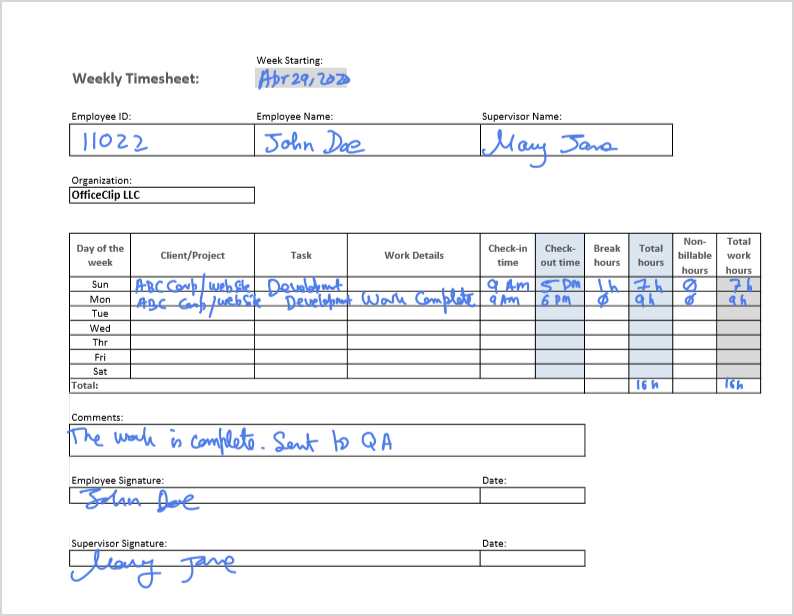The Timesheet helps in keeping proper track of time, ensures your team is paid accurately for the time they work, improves productivity, and automates the overall attendance process.

Recording accurate time has advantages:
- Managing Customer Projects: For time and material projects, the customer wants to see an accurate record of how much work is done. They also want to know if the deadlines are met and whether the project is on budget.
- Utilization of Resources: These can answer questions like, are the employees with the right skill levels working on the projects? Is a particular employee over or under-utilized?
- Accurate Invoicing: Often, when invoicing the customers, it is easy to forget some of the work done on the projects. This does not happen when the work is recorded at the point of service. Under invoicing results in lost revenue, and over-invoicing results in a bad reputation.
- Trend Analysis: Organization wants to know if they are spending more time on the customer than they are worth. Conversely, it helps to know if the company is neglecting customers who are high worth. Successful businesses often walk out of a deal that is not profitable for them.
- Regulatory Compliance: Government customers have compliance criteria (for example, DCAA) that need to be followed. It is not easy to do this without a good time tracking system.
History of time tracking:

- Historically most companies used paper Free Timesheet templates that were filled in by employees at the end of the week and signed by their supervisors. These were then sent to Accounting for billing. Paper written time entries often have mistakes and are prone to fraud. Some of these are difficult to trace as they get lost over time.
- Later, many companies migrated from paper to use excel or other spreadsheet templates to record time. This method, while better than paper, is not structured. Useful management reports were difficult to generate from the spreadsheet templates. They could also be easily changed, deleted, or lost in the folder structure.
Is there a better way to track time?

The ability to track time in a secured system at the point of service is the best way to track time. Some of the advantages of the distributed time tracking system are:
- Secured: Unauthorized changes cannot be made to the system. Usually, such systems are protected in multiple levels like password, two-factor authentication, secured socket layer, etc.
- Accessibility: They can be accessed via web and mobile devices with adequate security.
- Accuracy: The system can do some internal edit checks to find out if any obvious mistakes are made. For example, if an employee is supposed to work for 8 hours a day and billing for 12 hours, it can be easily detected.
- Audit Checks: An audit report can easily be made from structured data to find various patterns. For example, for DCAA compliance, government customers may want to audit if the employees are recording time every day.
- Vacation Tracking: Paid Time Off and vacation tracking can be easily managed with a structured time entry system. In addition, some software allows for accrual tracking.
- Profitability Checks: A report can be prepared to compare how much employee time spent on each customer vs. how much revenue is realized from them. From this report, it is possible to understand which customers are more profitable.
Features of a good Timesheet Software:
- Ease of use: Employees are often not fond of recording their time and consider this as their additional work item. The software interface should be simple so that they can the employees can quickly record the time and forget it.
- Flexibility: Companies have different pay and time recording cycles. These include Weekly, Bi-Weekly, Semi-monthly, and Monthly. A good system should be able to adopt one or more of these cycles.
- Edit Checks: Can the system does some checks based on how the company works? For example, a company may dictate its users not to work more than 12 hours a day or not to exceed 40 hours a week. Also, sometimes all work needs to be recorded under proper categories, projects, and service items.
- Reports: It is always not possible to predict what kinds of reports a company will need in advance. A good timesheet system should have a report generator that can accept various fields, groupings, and sort criteria according to the requirements of its users.
- Compliance: In many countries, government projects are closely monitored. In the United States government projects, the timesheets must be DCAA compliant with auditing capabilities built into the system. For example, an auditor may want to see all the edits made to the timesheet by any employee or their supervisor.
How Timesheet is used by various users?

How OfficeClip Timesheets helps?
- Simple Interface: OfficeClip timesheets interface is easy to use and provides all the necessary information details. Time tracking is something that we use every day, so our Time tracking system helps the employee to track time in very few and simple steps without any training. It is also easy for the supervisor to monitor employees and track work done in real-time.
- Affordable: Nowadays, there are many good and inexpensive timesheet systems available in the market. But OfficeClip timesheet software is quite affordable and can pay for itself in a few months.
- Customized Reporting system: OfficeClip reports helps to measure and analyze employee performance and also helps to estimate budgets and resources for the future. Users can also create customized reports as per their business requirements.
- Mobile App: OfficeClip mobile app is designed to track time by employees no matter where they are. The users can create new timesheets, submit the timesheets, and get them approved through various mobile devices like smartphones, tablets, etc.
- Other features: Along with tracking time through timesheets, OfficeClip applications have the ability to track Expenses, Time off’s and can also create Invoices.

